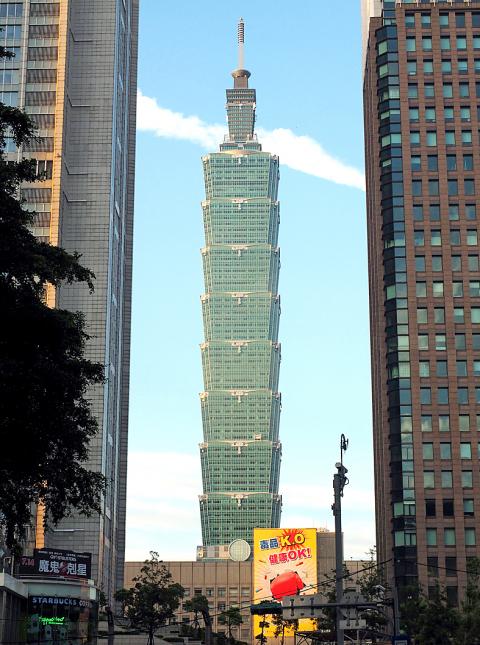Taipei 101 was on Thursday awarded the top honor in the Leadership in Energy and Environmental Design (LEED) building rating system, achieving the highest level — platinum — in the category of operation and maintenance of an existing building.
LEED is a green building certification program based on a rating system for design, construction, operation and maintenance of environmentally friendly buildings.
Projects receive ratings on one of four levels — certified, silver, gold and platinum.

Photo: EPA
Having received a platinum LEED v3 rating in 2011, the skyscraper moved up one spot to attain a LEED v4 rating this year, becoming the first skyscraper outside of the US and the only building in Taiwan to have achieved the feat, according to the organizer of the awards, the US Green Building Council (USGBC).
“With such distinguished leadership, Taipei 101 is showing it can stand taller among its peers without adding a single floor,” USGBC founder, chief executive and chairman Rick Fedrizzi said.
Besides evaluating figures that show how much more energy a building saves compared with a LEED v3 rating, the higher grade requires the candidate to reach out to the local community to build a green network, said Tim Shen, director of head of sustainability at the Asia office of CBRE, a company which provides real-estate services.
Having provided consultation to Taipei 101 on how the achieve the rating, Shen said the skyscraper signed a memorandum of understanding with state-run Taiwan Power Co (Taipower) last year to create a “demand response” partnership.
Under such cooperation, when electricity demand rises suddenly, the building follows a standard operating procedure to lower its usage for a designated period, Shen said.
The module could be implemented by Taipower and other buildings in Taiwan, he said.
Taipei 101 said that although its occupancy rate increased to 95.79 percent at the end of last year, a 50,000m2 increase compared with 2007, the building has saved 262 gigawatts per hour of electricity.
It is equivalent to a reduction of 139,083 tonnes of carbon emissions, which is Daan Forest Park’s total carbon absorption over 357 years, it said.
LEED-certified buildings are resource efficient. They use less water and energy, and reduce greenhouse gas emissions. As an added bonus, they save money, according to the USGBC Web site.

US climber Alex Honnold is to attempt to scale Taipei 101 without a rope and harness in a live Netflix special on Jan. 24, the streaming platform announced on Wednesday. Accounting for the time difference, the two-hour broadcast of Honnold’s climb, called Skyscraper Live, is to air on Jan. 23 in the US, Netflix said in a statement. Honnold, 40, was the first person ever to free solo climb the 900m El Capitan rock formation in Yosemite National Park — a feat that was recorded and later made into the 2018 documentary film Free Solo. Netflix previewed Skyscraper Live in October, after videos

Starting on Jan. 1, YouBike riders must have insurance to use the service, and a six-month trial of NT$5 coupons under certain conditions would be implemented to balance bike shortages, a joint statement from transportation departments across Taipei, New Taipei City and Taoyuan announced yesterday. The rental bike system operator said that coupons would be offered to riders to rent bikes from full stations, for riders who take out an electric-assisted bike from a full station, and for riders who return a bike to an empty station. All riders with YouBike accounts are automatically eligible for the program, and each membership account

A classified Pentagon-produced, multiyear assessment — the Overmatch brief — highlighted unreported Chinese capabilities to destroy US military assets and identified US supply chain choke points, painting a disturbing picture of waning US military might, a New York Times editorial published on Monday said. US Secretary of Defense Pete Hegseth’s comments in November last year that “we lose every time” in Pentagon-conducted war games pitting the US against China further highlighted the uncertainty about the US’ capability to intervene in the event of a Chinese invasion of Taiwan. “It shows the Pentagon’s overreliance on expensive, vulnerable weapons as adversaries field cheap, technologically

NUMBERs IMBALANCE: More than 4 million Taiwanese have visited China this year, while only about half a million Chinese have visited here Beijing has yet to respond to Taiwan’s requests for negotiation over matters related to the recovery of cross-strait tourism, the Tourism Administration said yesterday. Taiwan’s tourism authority issued the statement after Chinese-language daily the China Times reported yesterday that the government’s policy of banning group tours to China does not stop Taiwanese from visiting the country. As of October, more than 4.2 million had traveled to China this year, exceeding last year. Beijing estimated the number of Taiwanese tourists in China could reach 4.5 million this year. By contrast, only 500,000 Chinese tourists are expected in Taiwan, the report said. The report